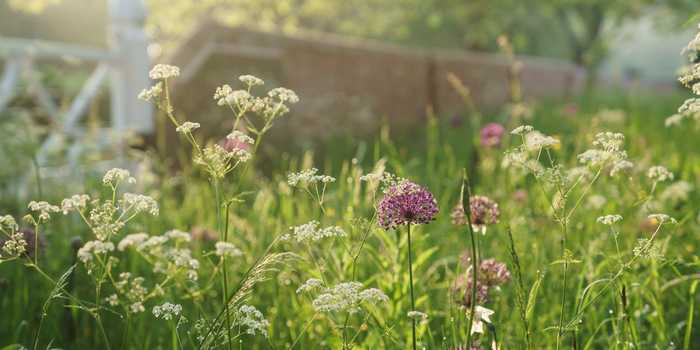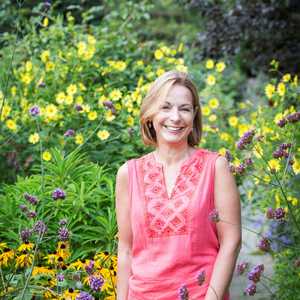Have a seat with...
Jo Thompson
Jo Thompson is listed by House and Garden and Country Life magazines as one of the country’s top ten garden designers and plantswomen. She has received four Gold and five Silver Gilt medals at the RHS Chelsea Flower Show, and in 2017 she won the People’s Choice award at the first RHS Chatsworth Flower Show. Jo's RHS work and international lecturing make her one of the most knowledgeable and respected in the businesses.
We had a great chat about all things landscaping, influences, lecturing and everything in between!
Hi Jo, how did you get into landscape design? Was it something you were always drawn to?
Everyone I work with knows how important and instrumental are the architecture and art of Italy to how I approach a landscape: form and functionality, human-centric, everything looking ‘just so’. Introducing harmonies of colour, harmony of architecture, there is instruction and inspiration wherever you look. These combinations often inform our work as a landscape and garden architecture and design practice, creating spaces all over the world that truly sit happily in their space, looking as if they absolutely should be there. I never want to ‘impose’ a garden upon a place – it has to deserve its creation or restoration.
Much of my childhood was spent in Italy, firstly in Rome, then as a student in Venice, followed by long summers at our Arceno home nestled in the Sienese hills. The atmosphere of Siena, the sound of drums through the year, the contrast with the rivalries and passions, never fails to make my heart soar whenever I return.
"...as a student I could dream away hours in the Olivetti Showroom on the northern edge of Piazza San Marco."
My first degree was in Italian and French, and I spent a lot of time in Venice and Rome, where my family still live. The colour and light in Venice are constant sources of wonder, as is the stunning architecture; so too are more contemporary spaces. As a student I could dream away hours in the Olivetti Showroom on the northern edge of Piazza San Marco. Designed and completed between 1957-8, it is very much a space designed to showcase products, as well as Carlo Scarpa’s talents as an architect. Monochrome shadows and hints of perfect colour mesmerise the onlooker, whether standing inside or peering in from under the dark arcade. His attention to detail in restoration work around Venice, and his skill at always maintaining a balance of new and old elements, are concepts I constantly strive for in our spatial design.
This classic Italian influence on garden and landscape design can of course be seen in many of the great British gardens. A place I find myself drawn to again and again is Iford Manor on the edge of the Cotswolds, where Harold Peto lived between 1899 and 1933. As a trained architect who discovered a great passion for plants, his work greatly influenced the Arts and Crafts movement; his skill and sensitivity in striking the perfect balance between formal and informal, horticultural and architectural, sit at the heart of how I approach a garden. A gentle intervention, lightly passing over the land.

That's fascinating! So, Jo Thompson Landscape & Garden Design has an outstanding international reputation - what has the journey towards this been like?
Seems a long one but inspiring and fascinating. It all started by doing the hard work of finding a sponsor for a show garden and after that I have been lucky enough to have sponsors approaching me. I’ve met lots of inspirational people along the way – artists, architects, clients, writers, who have all been of huge help and inspiration.
With such an impressive portfolio, do any of your projects stand out to you as particularly creative or innovative?
The long installation we created for the Brewin Dolphin show garden over and along the river Derwent at RHS Chatsworth Flower Show in 2017. We reused steel and created an architectural engineered sculpture that wound along and over the river, anchored by a fusion of perennials to create a meadow that felt as if it were part of the place.
You've mentioned your influences, would you say you have a signature style when landscaping? Or is it solely dependent on what your client wants?
I try to keep everything loose, relaxed, and always with biodiversity and sustainability at the heart of everything we do. I don’t want to create a heavy stamp of design, I don’t really want people to know that we have had a hand in what has been created, only that it all looks exactly as if it should be there.
We pride ourselves on exquisite planting that looks carefree and not overthought - even though it has been thought about a lot of course! It really stems from – and I know every designer says this – but the connection between the designer, the client, the land and my response to that which I don’t know until I meet them and visit the spot.
Tell us about your main influences and what inspires you when undertaking a project?
"...I am striving to create something that looks as if it should be there – that creates wonder and joy but that doesn’t ‘stand out’ or look ostentatious."
The location really is key to how a project comes to life. I am striving to create something that looks as if it should be there – that creates wonder and joy but that doesn’t ‘stand out’ or look ostentatious. Also the client is always a huge influence. I observe how they live, what help they might have with the garden or time they have to garden it themselves as this will greatly affect plant choices. I research the history of the site, discovering how it has evolved over time to create what is there now and deciding how I can influence and shape the next chapter in the landscape’s history.
You have a small but highly skilled core team - what would you say allows you all to work so well together to create such beautiful landscapes?
We keep the team deliberately small so that I can be involved with each project. We discuss every new project as a team, and then strip away anything that feels overly-managed or too considered. It’s so easy to want to include everything, but we need to bear in mind that a client will have to live with this garden, and it really needs to stand the test of time.
So, on to your lecturing career! What is the main focus of your talks and the message that you hope to get across?
"...it’s about what the land will love and what the clients feel comfortable with."
One of the things I am always asked, and so provides good material for lectures, is where the ideas come from. I talk about how an initial conversation and an ‘at one-ness’ with the site moves through design phases into the masterplan. I talk about how a gentle intervention is best and how one size doesn’t fit all - landscapes in neighbouring areas can be totally different in character and need to be treated separately. I also talk about how I take myself out of the equation when it comes to the final design – it’s not about what I want, it’s about what the land will love and what the clients feel comfortable with. Biodiversity and sustainability are also really important factors in everything we do so I often talk about what these really mean and how we’ve been working in this way for over twenty years.
You’ve been incredibly successful at the RHS Chelsea Flower Show, has this had a positive impact on your work?
Designing and creating show gardens for Chelsea and other flower shows is a bit of a labour of love and for many designers a right of passage. Chelsea offers an unrivalled platform for designers to showcase their work and I have certainly found it to be an incredible way to meet people and forge lasting friendships and working relationships. I have been incredibly fortunate to work with a number of brilliant charities and organisations in the past and hope to do so again in the future.
You emphasise the importance of biodiversity in all tasks that you undertake, what steps can people take to support biodiversity in their own gardens?
Grow more plants. It really is as simple as that. Growing plants helps to improve and maintain soil health, which in turn can support more life. Everything we do as gardeners now should focus on soil health and growing the right mix of plants to encourage pollinators. The other really easy thing everyone can do is be less tidy! Leave seed heads on their plants, let fallen leaves be worked in to the soil by worms, make compost from the plant material you do remove from the garden borders and reduce (or remove) chemical fertilizers and pesticides.
The question we all want to ask... What was it like working with historical gardens to restore a garden designed by Percy Cane? It sounds fascinating.
"...We really focused and spent time on research and consultation with archives and garden historians, looking at what will work without creating a pastiche."
As with many of our projects, the client is in the creative industries and has a great respect for the work of others, so tying this in with a new build house was a fascinating process. We really focused and spent time on research and consultation with archives and garden historians, looking at what will work without creating a pastiche. It was an incredible introduction to the work of Cane, which I’d been aware of, but hadn’t had the opportunity to go into in depth with. We often have the chance to do this and have worked on Nathaniel Lloyd’s next project after Dixter - a garden laid out by Vita Sackville-West, which is now in private hands, and also research into gardens which have clearly been designed but records don’t show by who, so real detective work is required.
Do you think it is important to have a place to sit and reflect when in nature? Is this something you incorporate into some of your designs?
We create gardens to be enjoyed. We love returning to projects to find that seats have been placed under tree canopies, or that furniture has been moved to enjoy different views while taking tea or a meal outside. It’s one of the first questions we ask our clients – where do you like to sit? – and we plan for as many incidental seating places, to reflect, read, call a friend, knit, whatever people like to do in gardens, to ensure the spaces we create and curate are as well-loved and enjoyed as possible.
Thanks for sitting down with us Jo, it's been great to talk!
Posted on August 13th 2021

